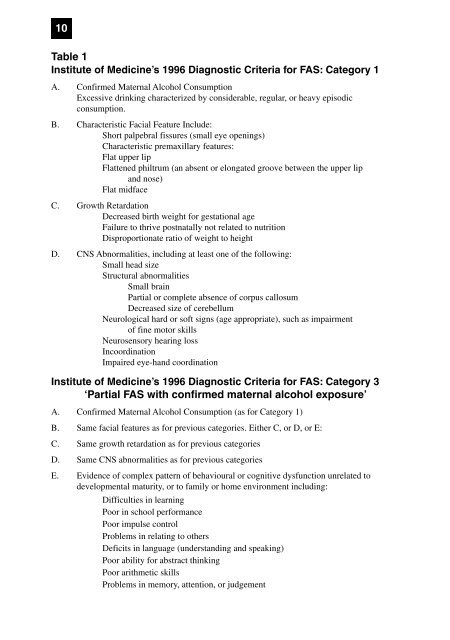Fetal Alcohol Syndrome A literature review - Department of Health ...
Fetal Alcohol Syndrome A literature review - Department of Health ...
Fetal Alcohol Syndrome A literature review - Department of Health ...
You also want an ePaper? Increase the reach of your titles
YUMPU automatically turns print PDFs into web optimized ePapers that Google loves.
10<br />
Table 1<br />
Institute <strong>of</strong> Medicine’s 1996 Diagnostic Criteria for FAS: Category 1<br />
A. Confirmed Maternal <strong>Alcohol</strong> Consumption<br />
Excessive drinking characterized by considerable, regular, or heavy episodic<br />
consumption.<br />
B. Characteristic Facial Feature Include:<br />
Short palpebral fissures (small eye openings)<br />
Characteristic premaxillary features:<br />
Flat upper lip<br />
Flattened philtrum (an absent or elongated groove between the upper lip<br />
and nose)<br />
Flat midface<br />
C. Growth Retardation<br />
Decreased birth weight for gestational age<br />
Failure to thrive postnatally not related to nutrition<br />
Disproportionate ratio <strong>of</strong> weight to height<br />
D. CNS Abnormalities, including at least one <strong>of</strong> the following:<br />
Small head size<br />
Structural abnormalities<br />
Small brain<br />
Partial or complete absence <strong>of</strong> corpus callosum<br />
Decreased size <strong>of</strong> cerebellum<br />
Neurological hard or s<strong>of</strong>t signs (age appropriate), such as impairment<br />
<strong>of</strong> fine motor skills<br />
Neurosensory hearing loss<br />
Incoordination<br />
Impaired eye-hand coordination<br />
Institute <strong>of</strong> Medicine’s 1996 Diagnostic Criteria for FAS: Category 3<br />
‘Partial FAS with confirmed maternal alcohol exposure’<br />
A. Confirmed Maternal <strong>Alcohol</strong> Consumption (as for Category 1)<br />
B. Same facial features as for previous categories. Either C, or D, or E:<br />
C. Same growth retardation as for previous categories<br />
D. Same CNS abnormalities as for previous categories<br />
E. Evidence <strong>of</strong> complex pattern <strong>of</strong> behavioural or cognitive dysfunction unrelated to<br />
developmental maturity, or to family or home environment including:<br />
Difficulties in learning<br />
Poor in school performance<br />
Poor impulse control<br />
Problems in relating to others<br />
Deficits in language (understanding and speaking)<br />
Poor ability for abstract thinking<br />
Poor arithmetic skills<br />
Problems in memory, attention, or judgement

















